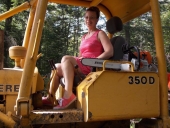

David Fraleigh wrote:Really the aim of my efforts is to end up with a property that is sparsely wooded with nice sized trees and with a relatively open accessible area underneath...

Daniel Kaplan wrote:Having worked around wildfires, how do wood chips burn? I assume they're not going to burn as intensely as something with lots of air access.
Daniel Kaplan wrote:I assume that after a few years they'll have broken down and become less flammable but somewhere in the middle they'll be punky and will hold embers really well.
Daniel Kaplan wrote:So are wood chips the perfect use for dead wood or a hazard to keep far away?
Daniel Kaplan wrote:I was hiking today through a section of forest that burned about 5 years ago and mostly it was just mineral soil with nothing on top. It seems that organic material beneath the mineral soil layer would tend to survive a fire a lot more easily so I was thinking about what deep-rooted plants could be planted.

wayne fajkus wrote:The oil was designed to drip out. So drain it out when done cause it was coming out anyway.


Travis Johnson wrote:That is true, but there is more than one way to do something.

Will Meginley wrote:
I had a friend growing up whose father did this with 2 x 4 lumber. He used cookies about 1/2 inch thick. The pieces looked like little bricks. He wood glued them in a herringbone pattern to a plywood subflooring and then covered the floor in epoxy. It looked really nice.

Travis Johnson wrote:Another extremely cheap floor to make is one made out of wood rounds or squares.
This was often used in old factories because old whale grease would land on the floors and be slippery. Plus everything was oiled back then, so oil dripped everywhere. To combat that, factories cut wood rounds, debarked to an even thickness of 2-4 inches. These were nailed to the floor or adjacent blocks of wood. They did this because the end grain would readily suck up the grease and oil preventing slipping when walked on.
There is two ways to do this. Logs can be debarked, then crosscut so that rounds are made, and then placed about the room as close as possible. They should be dried first though to allow for shrinking. Then concrete is made, and poured around the rounds of wood, just as if you were making a stone patio with flat rock pavers. But in this case, they are rounds blocks of wood. I have personally built this kind of floor for a woodworking shop.
The other way to do it, and is more refined, is to cut logs into square beams...8x8's, 6x6's, 4x4.s etc, and then crosscut them to 2-4 inches in thickness. Then place them end grain up nailing them to each other and the floor as you work across the room. This can be left natural as they did in the old factories, or sanded and sealed with polyurethane.
Sorry, I do not have a picture of that round block floor.

Ty Greene wrote:Thanks to everyone for the ID of Sumac
I noticed a strange smell when messing with them so I assumed it was the tree of heaven, they also have seeds hanging that look like windscattered type and I though that was another indicator...

Kate Downham wrote:I hadn't heard of this before. I am in Australia, normal car fuel here is 92%, and that's what we use for the chainsaw. There is usually a 95% option too - would this 95% fuel be worth it?

Travis Johnson wrote:I like a 18 inch bar and chain because it is a whole lot less teeth to file, and the bar and chain are cheaper to buy. The biggest reason though is, I get far more power. I have 6 inches of less drag on a 18 inch bar over that of a 20 inch bar, (2 inches longer on the top, bottom and nose to make 6 inches) so I get more power to the chain to cut through wood. Again I so seldom cut massive trees so having more power 99% of the time makes up for the few times I have to...wait for it...cross to the other side of the log and finish the cut. Oh the horrors of that! (insert sarcasm here)